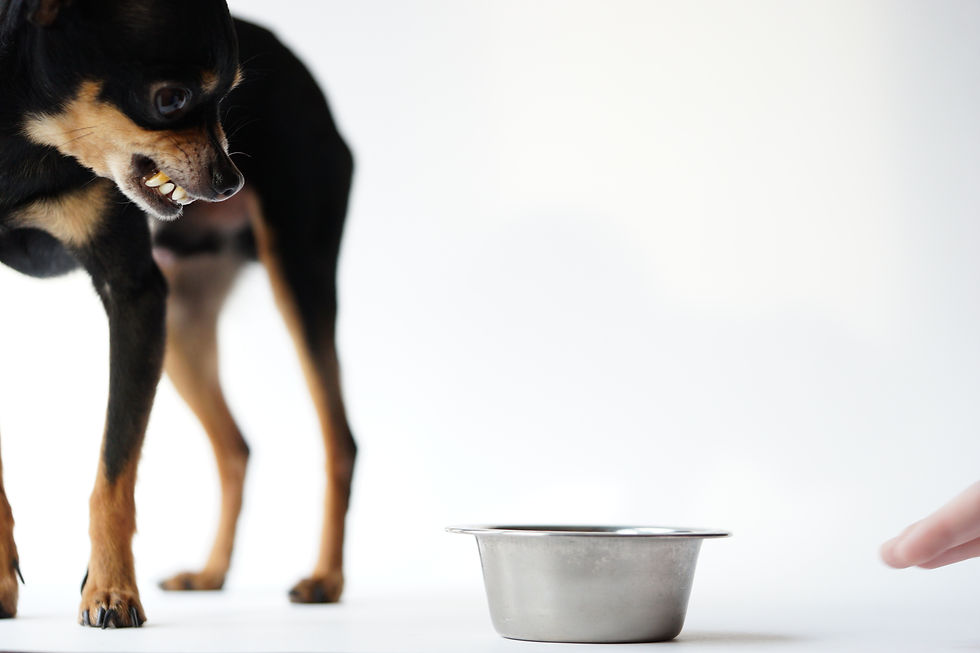Don't Touch My Stuff! Part 2
- Lisa Mullinax CDBC

- Jan 8, 2023
- 6 min read

Causes and Contributors to Resource Guarding
All behavior has more than one cause, including the dog's health, environment, learning history, and genetics.
Genetics
Nature AND Nurture. Behavior is not shaped by one or the other, but both. And certain behaviors, including resource guarding, have a genetic component (nature). If one parent is prone to resource guarding, it is much more likely that their puppies will inherit that trait.
The study of epigenetics - how the environment (nurture) alters DNA - continues to change our understanding of how behavior traits can be passed to future generations. If that same parent is in an environment where food is scarce, effective guarding of food is a good trait to pass on to puppies who will live in that environment.
Learning history
Dogs are constantly learning. They are learning which behaviors produce certain consequences (operant), and they are forming positive and negative associations (respondent). Both types of learning are happening at the same time and both affect a dog's future behavior.

The best example is with puppies. Puppies put everything in their mouths, and we are constantly taking things away from them. But what are they learning each time? People approaching = loss of Thing.
This can be prevented by always rewarding the puppy after taking things away. Give the puppy something great AFTER you take the object. Something great could be a good treat or a new toy. What do they learn now? People approaching/taking Thing = good for me!
Too often, the advice given surrounding resource guarding fails to take learning into account. Here are some common "tips" that range from unhelpful to dangerous:
Hand feed/feed from the dog's bowl. Depending on the source, this supposedly increases the bond or show the dog who "owns" the food. But if the dog is not prone to guarding, only guards things in their possession or high-value or stolen items, this won't have any effect.
Put your hand in the dog's bowl/take bowl while dog is eating. This approach risks creating guarding behavior by creating negative associations to people approaching and/or reaching. If the dog is already prone to guarding, this won't improve how the dog feels and runs a high risk of escalating the problem.
"Trade" the dog for a treat. If the dog isn't guarding, this is just bad training and creates dogs that don't respond until you show them a treat. If the dog IS guarding, this could lead to a bite to the hand offering the trade. I've also seen this backfire in other ways, like the dog who ran away as soon as a person offered a trade. Trade = losing Thing.
A trade can be a necessary and effective approach in an emergency. But if it is used too often, it could create or worsen problems.
"Claim space" from the dog by using your body to push them away from a resource.
If the dog isn't guarding, this will create conflict, increasing the risk that the dog will become defensive either in the moment or over time. If the dog is guarding, these approaches run a high risk of escalating the situation to a bite.
And since "claiming space" usually implies walking into the dog, it's putting some very delicate body parts in bite range!
Learning doesn't always change behavior immediately, which is why these tips often seem to work...until one day they don't.

The worst thing to do when a dog uses a threat display is punish them. Threat displays are big, orange, caution signs. If you ignore a growling dog or escalate your behavior to threaten the dog back, the dog is learning two things: 1) bad things happen when you approach, and 2) growling isn't clear enough for you, so a bite may be needed.
Growling isn't great, but it's better than a bite. A bite that requires medical treatment could lead to serious consequences for your dog, as medical professionals are required to report bites to animal control agencies. I've even seen child protection agencies get involved when children lived in a home with a dog that inflicted a bad bite when guarding.
So, how do you sort the good advice from the bad? Ask yourself how you would feel if a stranger at a restaurant did the same thing to you while you're eating. What if the food server yelled at you when you politely say you aren't done with your food? If it would cause you to feel angry, annoyed, anxious, or any other negative emotion, chances are high that it will have the same effect on your dog.
What To Do: Manage the Environment
Whether you have a new puppy guarding objects or your dog has slowly escalated their guarding behavior over time, management strategies - what to do until you can implement a behavior plan - all depend on what and how your dog guards.
Because of all the variables, getting help from a professional is highly recommended. I offer a Behavior Helpline to help owners develop a customized plan for managing and changing the behavior. In the meantime, here are some things to consider:
Mealtimes
Feed the dog in a quiet, low-traffic area of the house and leave them alone until they are finished eating. Pick up the empty bowl after the dog has finished eating and has left the room.
For Kongs and chews, feeding in a crate or other room, then retrieving the item once the dog has lost interest may be a solution. If the dog guards empty containers or spaces where scents of chews linger, avoiding these items may be the best management strategy.
Kitchen/Dining Areas
Minimize the risk of guarding found or stolen food with baby gates/pens to keep dog out of the kitchen or dining areas. If you generally eat your meals in the living room, crating your dog or confining them in another room is recommended.
Living Areas/Bedrooms
In the case of dogs that guard stolen items (including shoes, wastebaskets, etc) the best strategy is to keep items out of reach. Close bedroom doors, put wastebaskets under counters or in another room, and use gates/pens to prevent access to problem areas.
Strategies for Retrieving Items
For things that aren't harmful to the dog, these strategies can be helpful, especially with puppies and dogs that show mild guarding behavior.
My Thing is Better!
This prevents any negative associations to you. It isn't a "trade" because you aren't approaching your dog or offering the item to lure them away from the resource.
Pick up a toy or other item the dog likes and act like it is the best, most fun thing in the world. Squeak it, toss it in the air, and make it really interesting.
If/when the dog runs over with interest (likely forgetting the previous item), up the game - play your own version of keep-away to make it REALLY interesting.
When your dog is really interested, toss the item in another room and close the door.
Retrieve the stolen item while the dog is contained.
Scatter a handful of treats or a new toy on the floor for your dog to find before bringing them back in the room (as long as this does not trigger guarding, obviously).
I try to keep a few new toys in the closet for times like this. A holiday-themed toy on clearance in January is just as interesting to your dog in July, so stock up!
Wanna Go?
This strategy uses your dog's anticipation of a favorite activity to take their interest away from an item.
Pretend you're going for a walk or car ride. If your dog responds to "wanna go for a walk?" use that. If it's jingling the car keys or picking up the leash, that works, too.
Leash them or load them up in the car, close the door and retrieve the item.
Emergency Trade
If the dog has something that is harmful to them, an emergency trade may be necessary.
Without approaching the dog or reaching toward them, present the high-value item.
When they show interest, walk away, preferably toward a room with a door you can close.
If the dog follows you, toss the item into the room, then close the door behind the dog.
Retrieve the stolen item.
This strategy should ONLY be used in emergencies, not to repeatedly “trade” for things the dog has.
For Serious Problems
Management is a critical first step in changing this behavior, regardless of the level of guarding the dog exhibits. However, because there are so many variables in resource guarding behavior, if your dog has bitten or you feel there is a risk of a bite in the future, working with a certified behavior consultant is strongly recommended.
Fortunately, most forms of resource guarding can be safely managed and modified with the right approach.
(c) 2023 Serenity Canine. All rights reserved.
serenitycanine.com




Comments